
Alexander Mackenzie was a Canadian politician who served as the second prime minister of Canada, in office from 1873 to 1878.
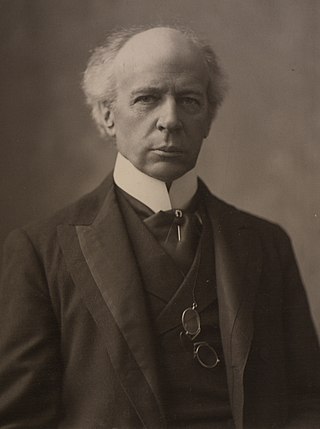
Sir Henri Charles Wilfrid Laurier, was a Canadian lawyer, statesman, and politician who served as the seventh prime minister of Canada from 1896 to 1911. The first French Canadian prime minister, his 15-year tenure remains the longest uninterrupted term of office among Canadian prime ministers and his nearly 45 years of service in the House of Commons is a record for the House. Laurier is best known for his compromises between English and French Canada.

24 Sussex Drive, originally called Gorffwysfa and usually referred to simply as 24 Sussex, is the official residence of the prime minister of Canada, located in the New Edinburgh neighbourhood of Ottawa, Ontario. Built between 1866 and 1868 by Joseph Merrill Currier, it has been the official home of the prime minister of Canada since 1951. It is one of two official residences made available to the prime minister, the Harrington Lake estate in nearby Gatineau Park being the other.

The National Capital Commission is the Crown corporation responsible for development, urban planning, and conservation in Canada's Capital Region, including administering most lands and buildings owned by the Government of Canada in the region.
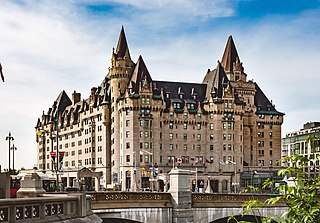
The Fairmont Château Laurier is a 660,000-square-foot (61,000 m2) hotel with 429 guest rooms in the downtown core of Ottawa, Ontario, Canada, located near the intersection of Rideau Street and Sussex Drive and designed in a French Gothic Revival Châteauesque style to complement the adjacent Parliament buildings. The hotel is above the Colonel By Valley, home of the Ottawa Locks of the Rideau Canal, and overlooks the Ottawa River. The main dining room overlooks Major's Hill Park. The reception rooms include the Wedgewood-blue Adam Room; the Laurier Room defined by Roman columns; the Empire-style ballroom and the Drawing Room featuring cream and gold plaster ornament. The hotel was designated a national historic site in 1980.

Sussex Drive, also known as Ottawa Regional Road 93, is an arterial road in Ottawa, Ontario, the capital of Canada. It is one of the city's main ceremonial and institutional routes. Travelling roughly parallel to the Ottawa River, Sussex Drive begins as a continuation of Sir George-Étienne Cartier Parkway at Rideau Gate, at the entrance to Rideau Hall. It travels south to Rideau Street, with the portion south of St. Patrick Street forming the northbound half of a one-way pair with Mackenzie Avenue. Both Mackenzie Avenue and Sussex Drive connect with Colonel By Drive at their southern end, which continues south alongside the Rideau Canal.
Harrington Lake is the summer residence and all-season retreat of the prime minister of Canada, and also the name of the land which surrounds it. The farm that surrounded most of the lake was the property of Margaret and John Harrington. John could not farm the land and moved to the local town of Iron Sides. The family stayed on the farm for many years and eventually moved to old Ottawa. The property is located near Meech Lake—where the Meech Lake Accord was negotiated in 1987—approximately 35 kilometres northwest of Ottawa, in Gatineau Park, amidst the Gatineau Hills in Quebec. The property is not open to the public, but the Mackenzie King Estate, the retreat of Prime Minister William Lyon Mackenzie King at Kingsmere, is a tourist attraction located 2 kilometres south in the park.
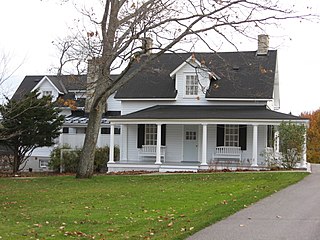
The Farm is a historic farmhouse and the official residence of the Speaker of the House of Commons of Canada. It is located in Gatineau Park in the community of Kingsmere, Quebec, Canada; near the country's capital, Ottawa. The Farm has been managed and maintained by the National Capital Commission since 1986. In addition to the Farm, the Speaker of the House of Commons is also provided a two-room apartment in Centre Block on Parliament Hill. The residence and its 1.74 hectares of grounds are not open to the public.
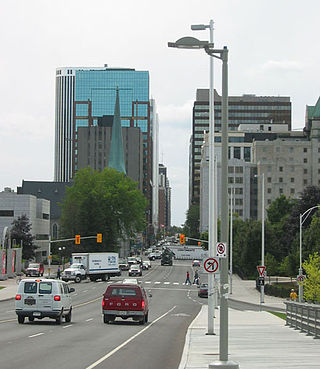
Laurier Avenue(French: Avenue Laurier) is a central east west street running through Ottawa, Ontario, Canada. Originally known as "Maria Street" and "Theodore Street", it was renamed in honour of Canadian Prime Minister Sir Wilfrid Laurier. Laurier House, the residence of Prime Ministers Laurier and William Lyon Mackenzie King, is located at the corner of Laurier Avenue East and Chapel Street.

Gatineau Park is a federal park located in the Outaouais region of Quebec, Canada. Administered by the National Capital Commission as part of the National Capital Region, Gatineau Park is a 361 square kilometres (139 sq mi) wedge of land extending north and west from the city of Gatineau. With a perimeter of 179.2 kilometres (111.3 mi), the park includes parts of the municipalities of Chelsea, Pontiac, La Pêche, and the City of Gatineau. The main entrance to the park is 4 kilometres (2.5 mi) north of downtown Ottawa, Ontario.

Sir Richard William Scott, was a Canadian politician and cabinet minister.

James Horace King, was a Canadian physician and parliamentarian.

The Home of Franklin D. Roosevelt National Historic Site preserves the Springwood estate in Hyde Park, New York, United States. Springwood was the birthplace, lifelong home, and burial place of the 32nd president of the United States, Franklin D. Roosevelt. Eleanor Roosevelt is buried alongside him. The National Historic Site was established in 1945.

Confederation Park(French: Parc de la Confédération) is a public park and National Historic Site of Canada, located in the downtown core of Ottawa, Ontario, Canada. It is bordered on the south by Laurier Avenue and Ottawa City Hall; on the east by the Rideau Canal and National Defence Headquarters; on the north by the Mackenzie King Bridge, the Rideau Centre and the National Arts Centre; and to the west by Elgin Street and the Lord Elgin Hotel.

Earnscliffe is a Victorian manor in Ottawa, Ontario, built in the Gothic Revival style. During the late 19th century, it was home to Canada's first Prime Minister, Sir John A. Macdonald. Since 1930, it has served as the residence of the British High Commissioner to Canada.
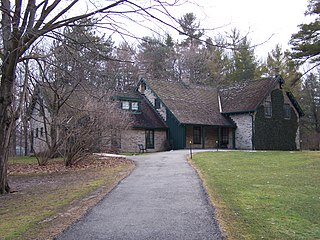
Woodside National Historic Site is the childhood home of former Canadian Prime Minister William Lyon Mackenzie King. King resided there from 1886 to 1893. The house is located in the city of Kitchener, Ontario, Canada. The house was built in 1853. A group of local citizens created the Mackenzie King Woodside Trust to preserve the house from demolition and acquire the property. The house has been restored to reflect the Victorian era, and is managed and interpreted as a unit of the national park system. The 11.5-acre (47,000 m2) site includes wooded grounds, gardens, and lawn. A video presentation is shown about the King family and Woodside. Victorian period programs and special events are offered, but the house is open fewer than 60 days a year, on select dates from October to mid-December. The grounds are open year-round.

The architecture of Ottawa is most marked by the city's role as the national capital of Canada. This gives the city a number of monumental structures designed to represent the federal government and the nation. It also means that as a city dominated by government bureaucrats, much of its architecture tends to be formalistic and functional. However, the city is also marked by Romantic and Picturesque styles of architecture such as the Parliament Building's Gothic Revival architecture.
The General Report on the Plan for the National Capital (1946–1950), or Gréber Plan, was a major urban plan developed for Canada's National Capital Region in 1950 by Jacques Gréber, commissioned by the Federal District Commission of Ottawa, Ontario.
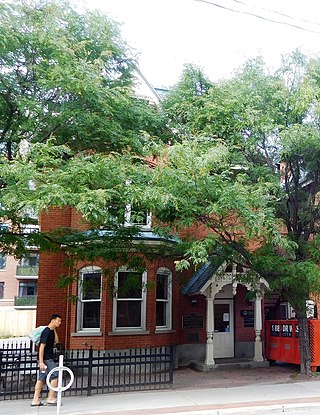
A former home of Canadian Prime Minister William Lyon Mackenzie King from 1901 to 1910 during his time as Minister of Labour. 331 Somerset Street, is designated as an Ottawa heritage property.


















